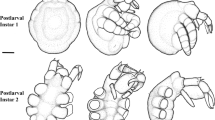Abstract
Larval development in Amphiglena mediterranea is direct in the parental tube, and larvae crawl away as young juveniles with a radiolar crown capable of feeding. The non-feeding larvae of A. nathae are initially brooded in the parental tube, and then have a swimming phase before settling and developing a radiolar crown. Developmental data and reproductive features such as sperm structure are combined with other morphological data for an assessment of the cladistic relationships of the species in the genus Amphiglena. Two species of Laonome are included as part of the ingroup. Six genera, representing a sister group to the Laonome/Amphiglena clade, are used as an outgroup. Two most-parsimonious cladograms were found, and the evolution of reproductive features are discussed. The monophyly of Amphiglena is indicated by features previously identified, as well as two features based on sperm morphology. At present a plesiomorphic larval form cannot be identified for the genus Amphiglena.
Similar content being viewed by others
Author information
Authors and Affiliations
Additional information
Received: 16 June 1997 / Accepted: 29 January 1998
Rights and permissions
About this article
Cite this article
Rouse, G., Gambi, M. Evolution of reproductive features and larval development in the genus Amphiglena (Polychaeta: Sabellidae). Marine Biology 131, 743–754 (1998). https://doi.org/10.1007/s002270050365
Issue Date:
DOI: https://doi.org/10.1007/s002270050365




